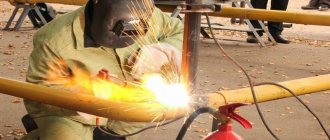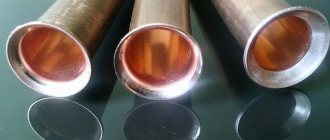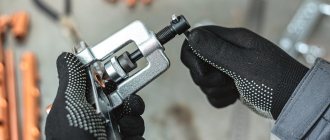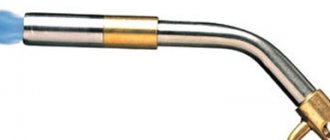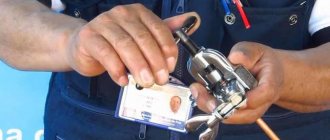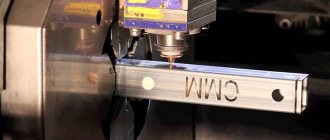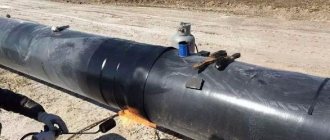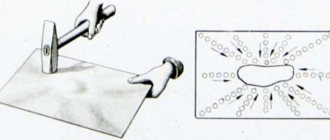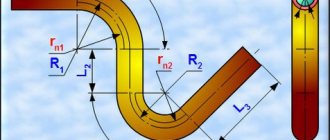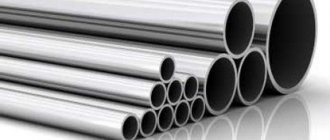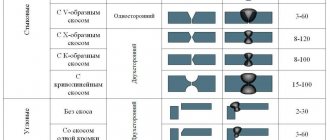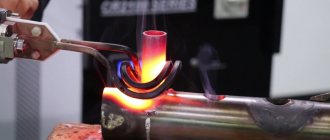Specialists often have to change both the configuration and other geometric parameters of pipe rolling to solve various problems. Most often, to change the shape and size of a tubular product, a technological operation such as flaring is used. It should be borne in mind that this operation is fundamentally different from what is called rolling, and these differences are significant.
The ends of these copper pipes are flared: expanded to a specific shape and prepared for connection
The essence of the process
Flaring of copper tubes is the process of deforming products of various types, which can be used to create various mechanisms. A similar technology is used when securing parts in boilers, condensers or other heat exchangers. Among the features of the work carried out, we note the following points:
- The thickness of the walls can be very different. Due to this, the outer or inner diameter changes.
- Copper tubes, which are made from metal with varying degrees of processing, are subjected to flaring.
Types of flaring
As a rule, the diameter changes due to stretching of the product. Using modern equipment, you can obtain a high-quality surface that is ideal for creating hermetic connections.
What is the result?
Our specialists have experience working with professional flaring equipment. We act quickly, accurately, without errors. Contact us, we guarantee the quality of future connections and the maximum life cycle of lines bent and flared on our equipment.
You'll get:
- fair price for pipe flaring;
- high-quality connection for quick pipeline installation;
- exceptional reliability of hermetic connection.
Cooperation with HydroPART professionals is your guarantee of high-quality installation of pipelines for a wide range of purposes (from classic water pipes to pneumatic, fire, oil pipelines, etc.) under our responsibility.
When might flaring be necessary?
Today, rolling of copper tubes is carried out extremely often. This technology is used in the following cases:
- The shape of the pipe needs to be changed. An example is obtaining an oval cross-sectional shape.
- Most often, flaring is carried out to change the outer and inner diameters. When connecting copper pipes, it is necessary to ensure perfect tightness, which is achieved by adjusting the surfaces to each other.
- Copper tubes of the required shape are not available on sale.
- It is necessary to change the size and shape of the tubes to suit specific conditions.
Flaring tool
Flaring is also performed in the manufacture of jewelry and various mechanisms. Various special tools can be used for work, for example, a cone flaring machine.
Features of the technology
In the modern automotive industry, there are eight types of flaring of copper, brass, aluminum and steel tubes. They are used to create detachable connections for various hydraulic and fuel systems in modern cars. Most types of these flaring are produced industrially on special machines in the factory.
Three types of flaring
But the main three types of flaring are the most common and are used both in the automotive industry and in the installation of various power equipment. These include:
- simple single flaring to a “D” cone, made at an angle of 45 degrees in the form of a single funnel, most hand-held tube flaring tools are suitable for its manufacture;
- double flaring of tubes to an “E” type cone is also performed at an angle of 45 degrees in the form of a single funnel with a double reinforced edge of the tube; a more specialized flaring tool with special nozzles is suitable for this;
- one-time flaring of steel pipes for type “F” fungus is performed with a special eccentric flaring.
Pipe flaring is a rather complicated operation technologically and requires careful preparation. Therefore, to obtain a high-quality connection using flaring, it is necessary to fulfill and observe the following conditions:
- The pipe cut must be perfectly straight,
- the walls of the pipe intended for flaring must have the same thickness over the entire diameter;
- The flaring area must be perfectly flat and smooth, and there must be no traces of residual deformation or cracks.
Stages of pipe flaring
It is possible to obtain a product of the required size and shape by using a technology that has long been known. The manipulation is carried out in three stages:
- The required gap is selected between the part and the copper tube sheet.
- Both elements are deformed when using a special tool.
- The pressure exerted is released.
It is worth considering that, regardless of the type of technology used, after flaring the metal becomes softer as it stretches.
Pipe rolling as part of the metal forming process
Pipe rolling is a necessary part of the process of partially changing the shape of pipes, due to which hollow metal products are given the required configuration or the diameter is expanded.
Pipes can be rolled in different directions, depending on the intended result. The process of changing the diameter is carried out on machines in the workshop or at home - using simple devices.
Using the rolling method, it is also possible to form products from sheet metal.
To change the original shape of the pipe, a rolling operation is used
Features of the rolling process
Rolling is an affordable process for manufacturing all kinds of metal parts or pipe sections of the required format. Each tube flaring tool has its own specifics, but this process is also used for other purposes - processing a metal rod or thin sheet metal.
The name of the process comes from a primitive device - special rollers are quite simple in design and operation, but they provide a wide rounding radius for the workpieces. Industrial production involves the use of forging rollers (rolls) through which a piece of metal passes.
Correct use of the tool guarantees high-quality and uniform deformation along a given circle or at a certain angle. For example, you can get a blank of the correct cylindrical shape or a curl for a forged gate using rollers for a profile pipe with your own hands.
Rollers are selected according to the thickness of the metal product; rollers with a large radius are often required. Not only steel becomes ductile when processed with the above devices. Plastics, polymeric materials and some rods, sheets and metals are deformed in a similar way:
- aluminum;
- black metal;
- soft alloys;
- galvanization.
Rolling is also called rolling a pipe on a special machine in order to obtain a bent workpiece
Attention! Today, pipe bending and rolling is a common service, but you can master this process yourself if you have an easy-to-use device. Such skills are applicable in various folk fields and industrial production, in the manufacture of welded structures - stairs, gates, furniture.
The most common methods of forming metal products after rolling a profile pipe:
- stretching;
- bending;
- winding;
- flaring of holes.
The process involves securing the pipe into the lumen using expansion, and the diameter of the pipe must be smaller than the opening. To ensure reliable connection, rolling equipment is used. But this concept implies different processes:
- Rolling as a method of changing the width of the inlet hole, lumen or diameter of the pipe during heat treatment and welding.
- Rolling of pipe bends.
- Rolling as a method of reducing diameter.
- Rolling a section of seamless pipeline.
- Flaring the workpiece to change the diameter of the pipe (increase).
Attention! Without experience, pipe rolling is not an easy task, and with excessive force, the metal will lose its ductility and may crack, and other signs of destruction will appear.
Rolling tools
Rolling of pipes and sheet blanks is not only different, but is also performed on different equipment. Most often, sheet bending or forging rollers are used - sheet metal is rolled between the rollers for uniform processing and obtaining a cylinder-shaped piece.
It is impractical to undertake such a process manually - it requires a lot of time and experience, even if it is just rollers for a pipe bender.
It is easier to deform products using a machine method, so it makes sense to contact a workshop if you do not have the skills or your own equipment, and alloy steel is difficult to work with.
Rolling of pipes from steel sheet blanks is carried out using special equipment, manual or automatic.
Rolling sheet metal between rollers produces a bend of a certain shape. Rollers and machine tools have a limit on the thickness and radius of the metal they conduct. An increase in the radius results in a decrease in the bending radius when forming a thin metal sheet on bending rollers.
Special machines are also used for flaring pipes and rolled steel. The universal tool is easy to use and allows you to mold products of the required shape.
Rolling of sheet blanks is carried out through the circumference of the upper roller, but it can also make the opposite movement.
After processing sheet steel with rollers, the length of the product increases slightly, and the cross-section becomes slightly smaller, due to thermal and mechanical treatment.
The most popular rolling tool:
- P series machine (products with a diameter of up to 40 mm);
- RT equipment (products with a diameter of up to 5.50-11.5 mm);
- T series equipment (products with a diameter in the range of 6-11mm);
- ST rollers (products with a diameter of 6-11mm);
- CP series equipment (parts of thick tube sheets);
- 5P series tool (thin-walled products).
Often, to change the bend of a pipe, a household pipe bender controlled by a handle is sufficient. In this case, the radial shape of the product is formed by means of a regulating roller during rolling.
Important! To prevent the pipe from flattening at the point of its bend, you need to pour sand into it before deforming it in order to preserve the natural shape of the walls as much as possible.
The three-roller pipe bender is also suitable for rolling metal products. Its purpose is to work with stainless steel products of rectangular and square shape. This tool bends such workpieces well into an arc. The pipe bender processes the product from both sides.
A three-roll pipe bender can easily process profile pipes - square or rectangular
Flaring of tubes with hand tools is carried out on aluminum and copper, since these are the softest metals. The limiting factor for industrial equipment is the power and wall thickness for which a particular device is designed.
Advice! You should not use thin-walled pipes for water supply in a private home. The result is simple flaring and joining, but it will not last long due to metal corrosion.
Specific terminology of different rolling methods
The concept of “pipe rolling” is a bit of a misnomer from a linguistic point of view. This term implies two opposite operations, and parts of the deformation of the workpieces are performed without rollers.
Summarizing the terminology, it is worth mentioning that rolling is:
- changing the shape of the pipe (turning into a round, square, oval shape);
- bending at an angle or along a radius;
- molding a round or flat blank into a tube-shaped product;
- end expansion or enlargement of one end of the pipe in order to prepare for joining with a part or fragment of the pipeline;
- crimping the end of the pipe end to create a hermetically sealed joint (reducing the diameter);
- cutting metal to give the end of the pipe a different shape and diameter.
Privaltsovka. The expansion process begins after the pipe is inserted into the forming hole. This eliminates the gap between the edges of the hole and the pipe bender. Next, you need to apply force to start the deformation process with a tighter joint.
Hand tools are used to flare soft metal pipes
Flaring of steel pipes is the most common method of deforming pipelines and other products.
This is a method of expanding the diameter of one of the pipeline fragments - for high-quality articulation of the sections.
After such processing, the communication sections are joined using a telescopic method - the end of one pipe fits as tightly as possible into the next fragment.
Flaring of copper pipes is often used when installing water pipes and air conditioning systems. This operation (as for all other metal pipes) is performed with the following equipment:
- clamp (expander);
- ratchet (adjusts pressing force);
- cone or funnel (changes the diameter to a larger value).
Attention! Cone-shaped equipment is used for malleable and ductile metals.
Rolling is the reverse process of flaring, reducing the inlet opening of the pipeline. Often, simple devices such as a vice and a hammer are used to narrow the diameter. Also, the edges can be given a different shape - like profiled pipes. This method also eliminates defects on the edges of the tubes that occurred during cutting.
Features of rolling at home
In everyday life, rolling of products made of copper, aluminum, galvanized and stainless steel is performed on universal bending rollers that can replace machines, pipe benders and special equipment. The quality of work depends on the thickness of the walls and the suitability of the equipment for the task.
A high-quality rolling tool is quite reliable, does not require repairs, and has been used for many years. For work in home mini-shops, compact machines of the RT, R, T, SR, 5R and ST groups (mentioned above) are used. Rolling a profile pipe is more difficult to do than transforming a rounded workpiece.
Advice! Many products are easier to bend at home after heating with a blowtorch - for greater plasticity.
When rolling copper or aluminum pipes with your own hands, it is important not to rush and monitor the deformation process. With excessive pressure, the hole may expand more than required, and it is very problematic to “seal” it back. Breaks are most likely on copper and steel pipes, so all stages must be done according to technology.
Ways to increase pipe diameter
Some materials are characterized by high ductility. That is why you can try stretching a copper blank onto a special conical template. This method is used extremely rarely, since it is difficult to obtain a high-quality part. There is a possibility of ruptures occurring in places where the maximum load is placed.
You can stretch the metal with an expander. The flared pipe in this case is characterized by greater quality. This device comes with interchangeable nozzles that can be used to adjust the diameter.
You can carry out the work in question using a cone. The process involves pressing a cone into the surface of a fixed workpiece in a vice, after which the product is removed. The result obtained is much worse than when using an expander, but the technology is used extremely often.
Specifics of flaring steel and aluminum.
When flaring steel or aluminum tubes, unlike copper and brass pipes, the rolling operation must be carried out slowly, constantly monitoring the condition of the surface, since when excessive pressure is applied, ruptures can occur when the metal is stretched.
This is due to the fact that steel and aluminum tubes have less ductility, so when a fungus or cone is formed, numerous microcracks can form. If there is uncertainty about the sufficient ductility of the material of steel or aluminum tubes, it is recommended to preheat them before flaring, respectively, for steel to 500-600⁰ C, and for aluminum to 200-300⁰ C.
Types of flaring machines
The flaring process is greatly simplified when using special devices. They can be manual or electric, used to work with the pipeline of a heating system or water supply, pipes of other systems, for example, air conditioning. There are also universal versions on sale. The most widespread are:
- Sample. A similar tool is used for working with copper or other soft alloys. Among the features include low cost and ease of use. However, during work, significant defects may appear on the surface.
- A mechanical tube flarer consists of a combination of a carbide roller that can be rolled along the edge to produce the required shape. When using it, you can make a workpiece with a smooth and symmetrical surface. The process is automated and allows you to obtain a high-quality surface. The applied force is increased by threaded and other drives.
- The electrically driven version is equipped with a whole set of replaceable attachments. It is purchased when it is necessary to speed up the production process. The only drawback is the high cost of such a device. It is recommended to purchase the device in cases where flaring is carried out with great frequency.
- Expander. This type is extremely common, as it allows you to deform the surface in just one movement. The simple design means that it is impossible to control the wall thickness. The expander is often used at home, as the device is inexpensive and easy to use.
Electric flaring machine
The mechanism is selected depending on the tasks assigned. For example, when mass producing certain parts, it is best to purchase a flaring machine with an electric drive.
Tube flaring technology
Tube flaring technology
The technology for flaring pipes can be illustrated by the operation of a hand-held flaring tool, which consists of a base with countersunk holes for the main pipe sizes and a corresponding set of nozzles.
Before starting work, the tube must be cut evenly, so that the cut is strictly perpendicular to the central axis. It is recommended to use pipe cutters specially adapted for this purpose. After this, we process the cut edge of the pipe with a file or cut off a chamfer using a rimmer and thereby remove all burrs from the inner and outer parts of the end.
Next, a tube is inserted into the hole of the base strictly along the diameter and clamped with a strong metal frame so that the edge of the tube protrudes slightly above the plane of the base level.
We take a nozzle corresponding to the hole, which is a steel cylindrical object on one side with a cone-shaped surface and a device for a pressure screw on the other side. Depending on the type of future connection, the flaring nozzle may have a different shape, so we select the surface of the required configuration.
Having installed the nozzle we need, we begin to gradually tighten the screw of the centering rod, pressing the surface of the nozzle onto the tube, gradually pressing it to the edges of the hole in the base. Upon completion of the operation, the rod screw is unscrewed, the base is disassembled and the flared tube is freely removed from the device.
The most important thing is not to forget to put the fitting nut on the tube in advance, otherwise you will have to repeat all the operations in the same sequence one more time.
Tip: as with any processing of metal products, it is recommended to lubricate the flaring area with a small amount of machine oil in advance.
Eccentric flaring machine
The common eccentric tube flaring machine is used to produce quality parts. Among the features of this version, we note:
- Pressure is transmitted when force is applied through a mechanical element. The tip is made of high hardness metal.
- The delivery set includes many different tips, changing which you can get a surface of different shapes.
- The cost of such a mechanism is relatively low. A wide variety of metals can be used in manufacturing, for example, those with high corrosion resistance.
To increase the transmitted force, a long handle is used. It is fixed in a special holder.
Situations that may require flaring
Today there is a very large assortment of copper tubes and connecting elements. It is because of this that choosing the necessary fitting or profile will not be difficult. But despite this, there are times when flaring parts at home cannot be avoided. Flaring may be required in the following cases:
- The product must be adjusted to a certain exact size.
- The required fittings are not available for purchase at this time.
- Products of the required shape are not manufactured.
How to choose a flaring tool?
In order to achieve high quality when flaring, you should correctly select the most suitable tool. When using the simplest devices, negative consequences can occur:
- Serious ruptures occur in the walls of copper tubes, which significantly reduce the strength and service life.
- Small cracks can cause the walls to wrinkle.
- It is difficult to achieve uniform thickness. Even a slight deviation leads to a decrease in the strength of the formed joint.
Eccentric flaring machine VALUE
You can select a tool for flaring copper tubes by considering the following information:
- Flaring depth.
- Internal diameter of the product.
- Certain characteristics of the material: hardness and degree of ductility.
- Outside diameter.
- Wall thickness. This parameter determines how difficult it is to process the workpiece.
- The distance by which the product can protrude beyond the boundaries of the locking mechanism.
- Distance between centers of internal holes.
- Presence and characteristics of connecting seams. Some blanks are obtained by welding the ends. The resulting weld may react differently to plastic deformation.
- The need to form grooves on the surface. Flaring can also create the required grooves in the copper tubing.
Most of the devices used are characterized by versatility. All mechanisms may also differ from each other.
Tools designed to carry out the work in question allow:
- Eliminate the possibility of severe cuts. This is achieved by gradually applying pressure, which is distributed evenly.
- Achieve uniform wall thickness. Moreover, a similar result can be achieved even if the workpiece initially had uneven walls.
- The hole inside the product becomes smooth and even.
Electrically driven devices are characterized by greater productivity. They are widely used today and are indispensable when it is necessary to deform a product with large wall thickness.
Areas of application
The practical application of pipe flaring has a somewhat specific situation.
This is due to the fact that the method of connecting pipes using flaring is a rather old technological technique, which, with the development of industry, was largely replaced by other types of connections. But a number of specific areas of application of flaring have not found a proper technological replacement and are still used in their unchanged form. As an example, we give the most typical and common areas of application of flaring, namely:
- In the energy industry, in the manufacture of water tube heat exchanger grids to create a strong, sealed connection between copper or brass pipes and the cylindrical holes of a steel tube grid. And also at housing and communal services enterprises for the corresponding repair of these water-tube heat exchangers. Flaring is increasingly used to secure pipes in various boiler equipment such as condensers, steam generators, economizers and oil coolers.
- In the household sector for creating detachable connections from copper tubes during the installation of air conditioning systems. Copper pipes are used to connect the external and internal blocks of the split system, through which the refrigerant circulates.
- In the food industry, in the manufacture of industrial refrigeration chambers, to create reliable detachable connections of copper and brass tubes directly at the installation site of the equipment, allowing it to fit into any room configuration with standard equipment.
- In alternative energy when installing heat pumps, for connecting copper pipes in complete analogy with split systems.
- At automobile industry enterprises in the manufacture of quick-release connections of steel tubes for the hydraulic brake system or copper tubes for the hydraulic clutch system of a car. Flaring and stamping are also used in the manufacture of various cooling radiators for internal combustion engines.
How to make a tool?
A homemade tool can be made for long-term use. The design is quite simple; it is represented by a frame made of two corners of similar geometry. When assembling the mechanism the following is used:
- Bulgarian.
- Two bolts with a thread of at least 8M.
- A corner 100 mm long can be used as the main material. It is best to choose a stainless steel version.
- Mandrels.
Grinding and drilling machine.
The corners are fastened together with bolts. To do this, appropriate holes are made using a drilling machine. Holes are drilled at the base of the chamfer.
Homemade flaring machine
You should work with such a mechanism in the same way as with many others that can be purchased in specialized stores.
Types of connection of elements
Today, two methods of connecting copper pipes are used: couplings and soldering. The method you choose during the process will completely influence the course of your actions.
When connecting products with couplings, you must adhere to the following procedure:
- You need to thoroughly clean the edges of the pipe.
- A coupling must be placed on the end of the tube.
- After this, the flaring machine must be put into operation. You need to insert the prepared pipe into it and turn the equipment screw until the bending angle reaches 45 degrees.
- After this, the processed product should be taken out of the flaring machine and connected to another element using a coupling.
Experts recommend that beginners and inexperienced home craftsmen use a coupling pipe connection after flaring.
When connecting pipes by soldering, follow these steps:
- Using a special brush, thoroughly clean the edges of the pipe.
- Insert the pipe into the flaring machine, and widen its edges so that you can insert a second pipe into it. In this case, there should be a small gap between the tubes.
- Apply flux to the pipe that is placed inside and insert it into the flared mating pipe. The insertion depth should be equal to the diameter of the tube.
- Heat the junction of two pipes using a gas torch or soldering iron. The solder should melt well and completely remove the gap between the surfaces of the tubes.
- Place the soldered elements on a horizontal surface and wait until they cool down to air temperature. Only after cooling can you work with the soldered pipe.
When choosing a flaring device, consider the diameter of the products you plan to work with. For heating systems, the cross-section range ranges from 32-40 millimeters. And for air conditioning systems, products are used whose diameter does not exceed 16 millimeters. You also need to rely on such criteria as the quality of the resulting socket and the possibility of using replaceable nozzles for different pipe sections.
How to flare a copper tube?
Due to the high ductility of copper, processing copper tubes made from this alloy is quite simple. Do-it-yourself flaring of copper tubes is carried out as follows:
- The workpiece is clamped in the holder so that it extends beyond the edges by 5-6 mm.
- Instead of a cone, a special nozzle is installed that fits the diameter of the workpiece.
- The fitting is put on, attention is paid to the direction of the thread.
- The die must be made of a material whose hardness is much greater than the hardness of the workpiece. It is pressed in, causing the edge of the end to deform.
- Instead of a stamp, a cone is installed. It is pressed in gradually. Only with uniform exposure can the required quality of the resulting product be ensured.
- After processing, the workpiece is inspected. If minor defects appear, they can be cleaned out.
Some workpieces are less susceptible to processing using the method in question. An example is brittle alloys, in the structure of which cracks and other defects may appear during deformation.
Execution Features
Flaring of copper tubes may be necessary if:
- the cut end of the tube must be given the required configuration;
- the end of the product must be prepared for its connection using a coupling (in this case, using flaring, the geometric parameters of the tube are adjusted, such as the internal diameter, bending angle, etc.);
- it is necessary to prepare the ends of the copper tubes for their connection by soldering.
Pipes are cut to length using a special tool - a pipe cutter for copper or aluminum pipes
To qualitatively flare a copper tube using special tools and devices, you must perform the following steps.
- The end of the tube whose connection needs to be made is carefully cleaned.
- A special coupling is put on the stripped end.
- Using a special tool or device, the end of the tube is flared until its expansion angle is 45°.
- After the procedure is completed, the end of the product is removed from the device. You can then immediately begin making the connection.
If you have never performed such a technological operation before and are going to carry out flaring with your own hands for the first time, then you should cut off the tube with some extra length (2–2.5 cm), which will allow you, in case of failure, to flare it again, cutting off the defective section.
Reamer - devices for stripping the ends of copper tubes
If it is necessary to flare a copper tube in order to connect it by soldering, then the sequence of actions for carrying out such a procedure will look as follows.
- The surface of the end of the tube that needs to be flared is carefully cleaned (for this it is best to use a special brush).
- Using a special device, the end of the copper tube is expanded to such an extent that the end of another tube can be inserted into it and at the same time maintaining a gap of 0.124 mm between the connected elements. Naturally, for this you need to use a measuring tool.
- The flux necessary to ensure the formation of a reliable and tight connection is applied in an even layer to the inner surface of the pipe section that has already been flared.
- The end of the second connection element is inserted into the flared part to a depth equal to the diameter of the pipe.
- Using a gas torch, electric soldering iron or blowtorch, the future joint is heated until the solder begins to melt.
- Melted solder fills all the gaps between the edges of the copper pipes being connected, resulting in a reliable and tight connection.
After the connection of the two copper tubes is formed, they must be placed on a horizontal surface and allowed to cool completely. Only after the joint has completely cooled can the resulting structure be used.
